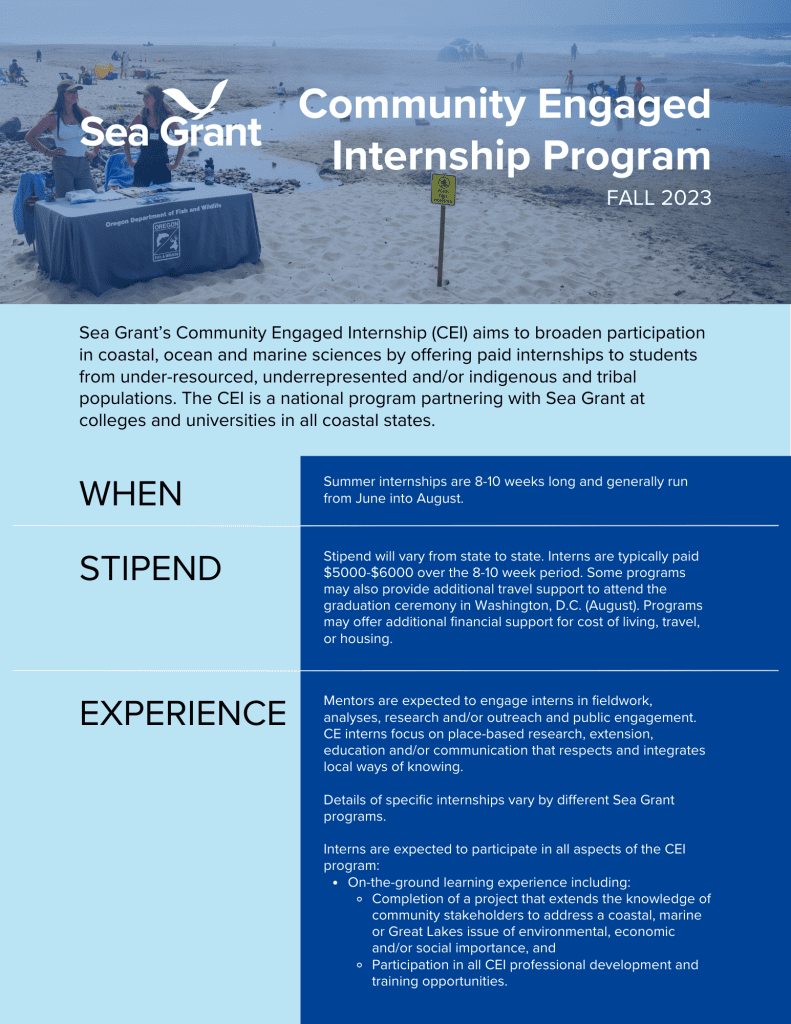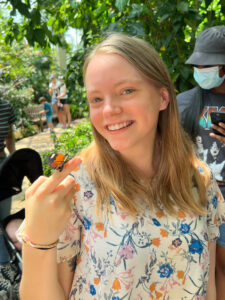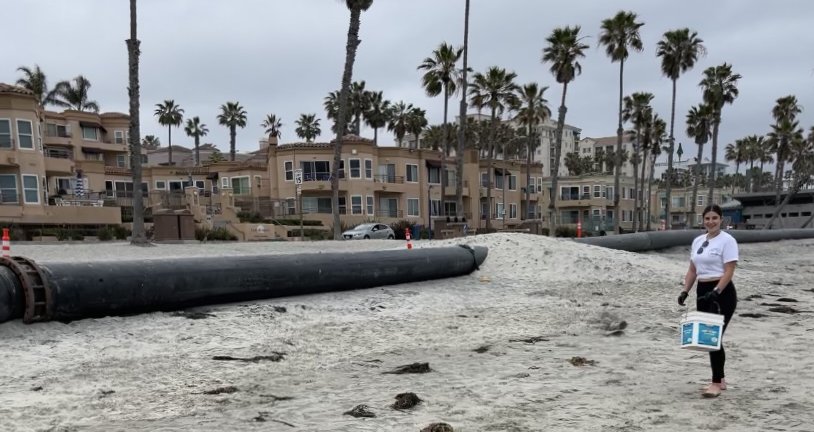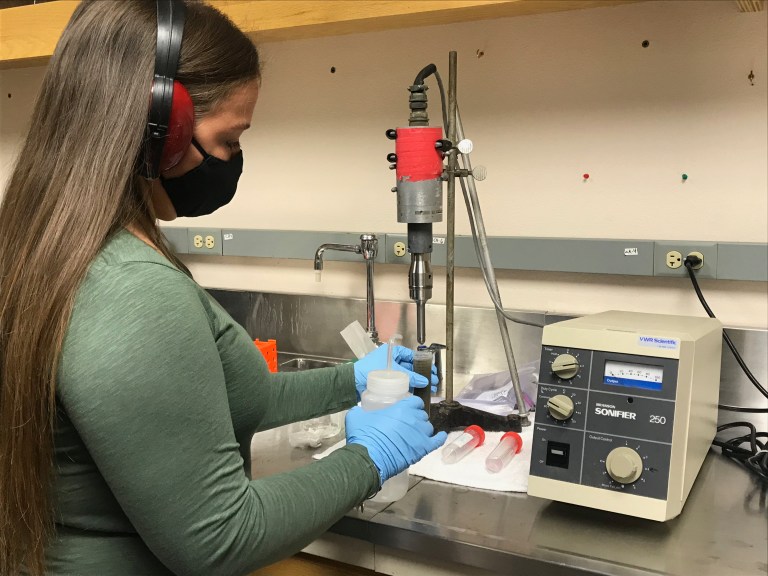Community Engaged Internship
Undergraduate Students
Broaden participation in marine and coastal professions
Community Engaged Internship for Undergraduates
The Community Engaged Internship is designed for undergraduate students from underrepresented and indigenous communities. The overarching goal of this internship program is to broaden participation in marine and coastal professions by providing training and mentorship to the next generation of scientists, decision makers and citizens. The program will do so by recruiting, retaining and engaging diverse students in place-based research, extension, education and/or communication that respects and integrates local ways of knowing.
The key components of this program are listed below, and details about specific internship opportunities will vary by Sea Grant program:
- On-the-ground learning experience through an 8-10-week internship over the summer months, including:
- Completion of a project that extends the knowledge of community stakeholders to address a coastal, marine or Great Lakes issue of environmental, economic and/or social importance, and
- Participation in all CEI professional development and training opportunities
- Mentoring by Sea Grant professionals, Sea Grant-funded researchers and Knauss Fellows
- Virtual professional development sessions
- Peer discussions with other interns in the cohort through virtual platforms
Students interested in CEI program opportunities should connect with their state’s Sea Grant program for information about the application process and deadlines, which are specific to each Sea Grant program.
General questions about the CEI program can be directed to seagrant.cei@gmail.com
Meet Former Interns






Featured Programs
FAQs for Sea Grant Programs
Who can participate in the CEI program?
All Sea Grant programs are eligible to participate in the CEI program. Programs can tailor several aspects of the program to their individual needs, such as selection of projects or program duration. Required elements for students are listed above.
Who is eligible to apply for the CEI program?
To qualify for the CEI program, applicants, must be enrolled in an undergraduate degree program at an institution of higher education, including 2- and 4-year colleges and universities, at the time of application. There is no citizenship requirement for the CEI program.
Generally, Sea Grant programs accept applications from students residing in their State (for example, a student residing in Alaska is expected to apply for the CEI program led by Alaska Sea Grant).
Applicants are strongly encouraged to connect with their State Sea Grant program to learn about any additional eligibility requirements.
What is meant by “diverse” students?
Sea Grant’s CEI program seeks to recruit interns from under-resourced, underrepresented and/or indigenous and tribal populations. The intent is to provide meaningful internship to students from groups that are historically marginalized in the sciences, including Black or
African-American, American Indian or Alaska Native, Hispanic or Latino, female, first-generation college students, veterans, LGBTQ+, and students with disabilities. The program is also open to students who have experienced, and worked to overcome educational or economic disadvantages, and/or who have personal or family circumstances that may complicate their career paths.
Ultimately individual Sea Grant programs define what “diverse” students mean for their state. Many Sea Grant programs do not exclude student applicants based on diversity criteria, and rather use language in their recruitment materials to strongly encourage diverse applicants. Some programs ask for a diversity statement or include a question in the application so that the student can self-identify how they meet the goals of the program.
What is meant by “under-resourced, underrepresented and/or indigenous and tribal populations”?
Each Sea Grant program defines these terms for what is appropriate in their state and the populations with whom they work.
As outlined in Sea Grant’s 10-year DEI vision document, underserved populations are those that have experienced low levels of access in coastal/ocean/marine sciences. Underrepresented populations refer to persons for whom representation in our programs is smaller than that of the general population.
What kind of projects have past interns worked on?
In the past, interns have worked on a variety of projects including:
- Great Lakes Geospatial Data Visualization
- Hawaiʻi Sea Level Rise Citizen Science Project
- Traditional Ecological Knowledge and Great Lakes literacy
- Manoomin (wild rice) education and outreach
- Green Infrastructure, Climate Adaptation, and Geodesign
- Habitat use of shellfish aquaculture by fish and invertebrates
- Assessment of larval fish shrinkage with preservation
- Tree Planting to discourage reed canary grass and watershed education
- Effects of Sea Lamprey on Lake Trout
- Environmental modeling of native wetland plants to build invasive resistance
- Distribution study of New Zealand Mud Snail in Boardman River
- Farmer engagement on flood resilience practices in eastern North Carolina
What is the cost of the internship?
Interns are typically paid $5000-$6000 over the 8-10 week period. Some Sea Grant programs may offer additional cost of living stipends, travel subsidies, or provide housing ($1000-$2000) depending on the location of the intern.
Who pays for this internship?
Sea Grant programs use their own funds to hire an intern. This might include funding from the omnibus, state funds or extramural grant awards. Sea Grant programs are expected to provide their own funding for interns.
Can interns receive college credit?
College credits for internships can be arranged with individual academic departments; Sea Grant programs typically do not provide for-credit academic opportunities.
Can Sea Grant programs have multiple interns?
Yes, Sea Grant programs can have as many interns as they can fund and manage. Regardless of the funding source, any student who is recruited as a CEI intern will have the opportunity to participate in the CEI program.
When does the internship begin? How long is the internship expected to be?
Sea Grant programs can choose their own start and end dates, but the timeframe should roughly correspond to the summer months, starting the first week in June and ending at the end of the first week in August. The period should cover approximately 8-10 weeks of full-time (40 hrs per week) participation.
Doing so will allow students to participate in all professional development and cohort-building activities. Programs are welcome to use other models and timeframes that are more suited to individual students’ needs.
Who is supposed to supervise the interns?
Interns can be supervised by a Sea Grant staff person, or an individual from a partner organization such as a faculty member, or employee of a state environmental agency or non-profit group.
What are best practices for recruiting interns? How do you recruit hosts?
There are various strategies that Sea Grant programs can use to recruit diverse interns. For example, programs should consider drafting an internship flyer and sharing the internship information with a wide variety of partners, including community partners,
administrators of fellowships and faculty.
Programs should also consider cultivating relationships through local and regional meetings, professional society meetings, or other networking opportunities, throughout the year. Sea Grant programs should also consider connecting with universities and campus groups that specifically serve underrepresented students (e.g. Historically Black Colleges and Universities (HBCUs), cultural centers, programs such as Louis Stokes Alliances for Minority Participation (LSAMP).



